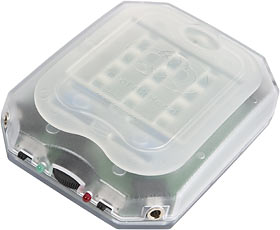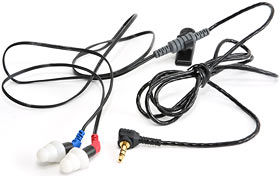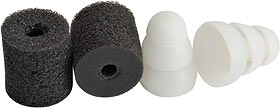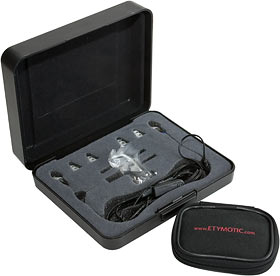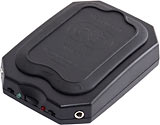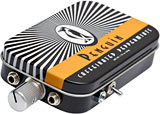
HeadRoom Total BitHead and Etymotic ER-4S earphones
Review date: 9 August 2004. Last modified 03-Dec-2011.
This...
...plus this...
...equals arguably the best portable music listening apparatus you can buy.
It's not for everyone, but if you're looking for a headphone rig that'll give you audiophile-snob sound quality (well, OK, maybe not, depending on the level of snobbiness we're talking about) even while you're jogging, this is it.
Regular readers will recognise the funky clear thing as a HeadRoom BitHead; I've reviewed it before. The BitHead and simpler, cheaper AirHead both look the same, but HeadRoom have recently started making these clear plastic versions (with translucent rubber, for the battery bay cover!), and they cost the same as the black ones.
I now find it hard to imagine why you'd want a black one.
This isn't, actually, a basic BitHead; it's the upgraded Total BitHead version, which costs $US269, seventy bucks more than the basic model. There's a Total AirHead as well (HeadRoom have a bit of a thing for whimsical product names...), which sells for $US199, $US50 more than the basic model.
The basic feature set of the Total variants is exactly the same as the cheaper versions. They both work as analogue headphone amplifiers with two outputs and switchable crossfeed (read my review for more about that), and both BitHeads also work as a USB audio adapter for use with PCs, Macs and laptops, and you still get a choice of battery power, optional AC adapter power, or (for the BitHeads) USB power to run them.
The Total versions of the amps are meant to sound better, thanks to higher-spec, more expensive resistors and capacitors.
(Can different resistors sound different in ways not explained by mere ohmage? Sure they can!).
If nothing else, higher spec components will both start out closer to their nominal values than cheap components probably will, and they'll also stay closer as they age. The Total BitHead also has a better op amp chip than the plain version.
HeadRoom explain the philosophy behind the parts upgrade on their product pages. Personally, I don't think I really want to "almost feel the gravelly moisture at the back of a singers throat", but if you enjoy sticking your fingers down other people's gullets then don't let me stop you. I suggest you wear a raincoat.
Away from the land of marketing hyperbole, it's not crazy for even hard-nosed empiricists to buy the Total variants, particularly the re-chipped BitHead. The upgraded amps, after all, only cost about 35 per cent more than the basic models, which aren't stratospherically expensive in the first place. HeadRoom have not seized this opportunity to gouge their more gullible/discerning (strike out whichever does not apply) customers.
If you intend to use the amp only for mobile listening, and your mobile listening is not primarily done in a breezeless, birdless forest, there's unlikely to be a lot of point dropping the extra dollars on a Total Anything. Even headphones with a ton of "isolation" (ambient noise blocking ability) will not, I think, intercept so much street/bus/train/skydiving noise that you're likely to get a whole lot of value from the Totals. If you do manage to make typical urban ambient noise irrelevant with an appropriate combination of isolation and volume, you're probably going to be damaging your hearing even as you fail to hear the horn of that onrushing Volvo.
And now, those funny looking headphones.
Well, earphones, actually. Or, to be really precise, "canalphones". These are Etymotic ER-4S 'phones, and like all canalphones they go right into your ear canal, in exactly the way that we're constantly told that nothing should.
Regular "ear-bud" headphones sit over the ear canal. Some of them point straight down the canal. Others seal a bit better with a forward- or rearward-pointing design that hooks into the ear with varying degrees of success depending on whether or not the ear-buds have a headband or clip, and also depending on what shape the user's ears are.
Cheap ear-buds can work pretty well; lots of people are happy enough with them, and they're a good choice of headphone if there's a good chance of them getting lost, broken or stolen. $US25 will buy you a pretty fancy pair.
The ER-4S is, or are (I never know whether to talk about headphones in the singular or the plural...), not in that price range. As I write this, HeadRoom have the ER-4S on sale for a mere $US219, ex delivery.
HeadRoom's prices are usually very good, and they are here, too; you won't find these earphones much cheaper than that, anywhere.
(List price, by the way, is $US330. Some people presumably paid it when the ER-4 range was brand new, back in late 1997.)
Why on earth should you countenance spending ten or twenty times the usual price of a set of tiny earphones? Read on.
The canalphone difference
Sound needs a medium to travel through, as everyone who doesn't take popular sci-fi spaceships seriously knows. Any solid, liquid or gas will do in a pinch, but most people I know do most of their listening through air.
It's very nice of the air to provide a way for sound to get from musical instruments, vocal cords, loudspeakers, headphones, entertaining pyrotechnics and the like to our eardrums, but it creates a basic problem with music reproduction. When you've got an electricity-to-vibration transducer over there, and your ears over here, there's no way to prevent a whole lot of acoustic energy being wasted vibrating a bunch of air in the room that's nowhere near your ears.
This problem gets worse and worse as the frequency of the sound drops. Lower frequency sound moves the air a lot more at a given volume level, and needs a lot more power to do it. This is why a tinny battery-powered transistor radio can be plentifully loud, but you need a big butch fin-covered amplifier to run a chunky subwoofer.
Research proceeds into black-magic sound reproduction schemes that use beat interference in beamed ultrasound to create audible frequencies in particular places without needing to shake up a whole room full of air, but don't hold your breath for any of those things to show up in your living room. They'll probably be used for advertising purposes first; soon, everyone will be able to enjoy voices in their heads.
The room-full-of-air problem explains why headphones can deliver good bass, and ear-shattering volume, even though they only have dinky little transducers and run from tiny amounts of power, by loudspeaker standards. Headphones, essentially, create their own little sub-room inside each ear-cup, and only bother with oscillating the air in there. "Closed" headphones keep most of the energy inside; "open" headphones leak a lot of their sound into the outside world. There, it sounds exactly as you'd expect a teeny low-power speaker to sound - quiet and bassless.
Headphone designers still face a shadow of the loudspeaker problem, though; they're making a device that depends, at a fundamental level, upon the ability to inject sound directly into the ear, but the electricity-to-audio transducers in that device aren't in the ear. They're hanging out there, as much as an inch away from the ear canal entrance. Even ear-buds don't really seal around the ear canal, unless you push on them with your fingers.
But canalphones do. They sit in there like an expanding foam earplug. Pretty much exactly like one, in some cases. Some cheap canalphones are open, but practically all of them are closed; they leak very little noise, in either direction.
In theory, you could go swimming while wearing sealed canalphones. You'd just need a really long extension cable back to your MP3 player at the side of the pool. Or a $10 cassette player, a Zip-Loc bag and some skill with silicone sealant.
These are what pass for earpads, on the ER-4S. The standard "tips" are the funny white curvy pagoda things. They're made from silicone rubber, so they're tough, and washable. You get three subtly different sets with the earphones.
The black earpads are made from the same sort of foam as expanding earplugs, and work the same way. You put 'em on the earphones (it's quite easy to pull off one set of tips and push on another), roll them into a narrow cylinder, and then quickly jam them into your ear before they expand again. The foam's quite durable, so it'll survive numerous insertions, and it's at least somewhat washable. Replacement foam pads are pretty cheap. You get five pairs with your ER-4S kit.
Inside the earpads, the business end of the ER-4S is really, really small; around three millimetres in diameter. But there's an even smaller piece inside it - the green filter that stops ear-schmutz from gunking up the driver inside.
The filters are replaceable...
...using a little tool that comes with the kit. Both ends of the tool unscrew, revealing a screw thread on one end for fishing out dirty filters, and a storage tube on the other for the minuscule spares.
The filters aren't just earwax interceptors, as you'll discover if you try listening to the ER-4S without them. They also greatly attenuate the treble, acting as a mechanical low pass filter matched to the earphones' drivers. Without the filters, the ER-4S sound has a definite dentist-drill aspect.
You only get four spare filters with the normal ER-4S kit, but mine was a bit non-standard because HeadRoom had used it for product photos before they sent it to me, and a couple of things had gotten mixed up as a result. HeadRoom have assured me that they do not, as a rule, open and paw over the Etymotic kits they sell, or put them in their ears, or anywhere else.
This, therefore, is not quite the standard ER-4S kit, but it shows you the important parts. The earphones themselves, of course, with a lapel (or shirt, or whatever) clip widget that lets you hook the cable to your clothes so the whole five foot cord doesn't hang from your ears. One big hard case with enough room for all of the stuff; one little zip-up soft case for travel use.
Not visible in the above picture is one (1) standard eighth-inch to quarter-inch stereo plug adapter, and one (1) little paper manual (which you can also download in PDF format).
Listening
Looking at the extreme smallness of these things - the barrels of the earphones, where the transducers live, are only seven millimetres in diameter - you might fairly wonder how it is that they can produce any significant bass. It's basic hi-fi gospel that There Ain't No Replacement for Air Displacement when it comes to bass; regular ear-bud transducers are already pretty darn small. How on earth can a sorry miserable squashed thing like the Etymotic transducer work?
Actually, it's not immediately obvious that canalphones like these can make any noise to speak of. We're all familiar with public-transport Walkman listeners whose heads go TSS-TSS-TSS-TSS very audibly as they hum along tunelessly to Phil Collins, but even with something obnoxious cranked up to eleven, the Etymotics produce only a thin trickle of sound if they're not in your ears.
And yet, they work.
Plug 'em into your ears and you're initially struck by the kind of isolation that normal sealed headphones dream about. Even a head-clamping set of oil-filled aviation headphones isn't likely to give you the 33dB quoted isolation of the ER-4S with the standard rubber earpieces; the foam earpieces have a quoted isolation of 41dB, which verges on amazing (although they'll let more sound through as they age and soften).
I could do critical listening with the ER-4S even in my main computer room, which is full of air-cooled computers that give an ambient noise level of about 50dBA where my head is. That's hardly deafening, but neither is it quiet; it's quite unsuitable for most headphone auditioning.
Good sealed headphones work OK with 50dBA ambient noise. Open headphones work, but let pretty much all of the ambient noise through; if you want to avoid hearing it, you're going to have to crank the volume far enough that you'll risk eventual hearing damage.
The ER-4S with foam earpads practically vanished the noise altogether. I could hardly even hear my antisocial keyboard, which pushes the head-level ambient noise up to about 63dBA when I'm typing furiously. It didn't take much music volume at all to mask what noise got through.
Look at HeadRoom's test results for the ER-4S and you'll see that the isolation graph starts out pretty good at the bass end and then, as normal for sealed headphones, gets better and better (which is to say, a larger and larger negative number) at higher and higher frequencies. Unlike every normal set of sealed headphones, though, the ER-4S graph drops right off the -50dB bottom of the graph at only a bit more than 400Hz, and only comes back above the waterline at a few spots above that.
This is why these canalphones - and others - work so very well at getting rid of fan noise and other mid-to-high-frequency stuff. If you've got a lot of low-frequency ambient noise to deal with, the isolation won't be as impressive.
The frequency response graph shows useful response all the way down to 20Hz, which I can believe; that's an easy octave more bass than you'll find in most music, and the ER-4S performed very well with all of my bass-heavy test tracks. The HeadRoom graph goes plausibly wiggly above 2kHz, and doesn't drop like a stone until past 15kHz, which is as much treble as any normal human can hear.
Etymotic say the ER-4S is designed to "compensate for the high frequency emphasis in all CD recordings", a claim I'm not so sure about, but there does indeed seem to be a treble dip above about 5kHz, coming back to what looks like a resonance peak around the 15kHz response limit. A lot of popular music does have rather overactive treble, especially when listened to through headphones; the people mixing it assume you'll be listening through speakers in an environment not too friendly to treble, so they add extra. And these canalphones certainly don't sound muffled.
Actually, they sound uniformly great. Solid but not overemphasised bass, pretty much zero midrange colouration, crisp but not tizzy treble, and dead smooth integration of all three ranges.
Etymotic claim 20 to 16kHz response at plus or minus 4dB, slightly more relaxed than the usual 3dB standard, but indicative of an admirably flat response overall; most headphones have peaks and troughs in their midrange and treble response of a lot more than four decibels.
The world's full of cheap headphones that claim "20-20,000Hz" or even wider frequency response, but those specifications are usually what we professionals refer to technically as "complete lies". You'd need to hang the response graph on the wall of a tenth-storey office and finish the bass and treble ends of the plot in the basement to accurately describe most inexpensive headphones' performance at those frequency extremes.
I ran my usual orchestral, jazz, mellow vocal and electro test tracks through the ER-4S, and then clicked on random play and enjoyed this, that and the other.
I could never forget I had thingies in my ears - more about comfort in a moment. And the sound from the canalphones is noticeably more "inside your skull" than that from my usual big squishy circumaural headphones, because sound from outside-the-ear 'phones is mildly affected by the shape of the ears, which the brain is very good at noticing.
But, soundwise, I've no complaints at all, except the usual one about very good headphones, which is that they mercilessly present to you every imperfection of any poorly compressed MP3s, non-pristine vinyl, and crummy commercial releases.
A set of normal headphones that sounded as good as the ER-4S, cost the same, and had even half as much isolation, would be a very good buy.
My only real complaint about the sound of the ER-4S is that the cable is noticeably "microphonic"; it conducts noise to your ears when something bumps or brushes the part of it that's hanging from the 'phones.
Traditionally, "microphonic" usually refers to components like valves and turntable cartridges that work electrically like a microphone, but in headphone parlance it's all about sound being physically conducted up the cable. Etymotic make an optimised-for-unamplified-use ER-4P which apparently has a softer, less microphonic cable; some Etymotic customers have hybridised their canalphones with cheap "EarHugger" clip-on 'phones to fix the problem, too.
Also, as always when your ears are plugged, you can hear your breathing and chewing and other bodily noises more clearly.
But, apart from that, I have no reservations in recommending the ER-4S sound.
And yet, when hanging out in the air, they sound even more like hamster flatulence than do normal small headphones.
Why is there such a huge difference when you cram 'em into your ears?
Well, earphones that plug the ear canal have very good mechanical efficiency. Even compared with conventional headphones, a large amount of the audio energy coming out of their transducers makes it to the listener's eardrums. This fact is what makes piezoelectric earphones work.
Piezo earphones are the world's cheapest in-ear audio devices, and they've got a little piezoelectric transducer in them that can emit a tiny bassless squeak of sound energy from an incredibly low input power.
How low? Well, piezo earphones are the only listening hardware that'll work when plugged directly into an unamplified crystal radio. Crystal sets run entirely from the power input from their antenna. If you don't live rather close to big old AM transmitter mast, any antenna that'll fit in a room is only going to suck a few microwatts out of the air, and not nearly all of that will make it to the earphone socket.
Crystal sets can drive loudspeakers, if you're in a strong signal area and use an antenna wire at least a hundred feet long. But a piezo earphone will pretty much run if you touch its input wires to a piece of paper that says "IOU 25 electrons".
The superb mechanical efficiency of the ear-plugging headphone design also explains how the minuscule drivers of the Etymotic headphones can create such great full-range sound, with plenty of bass.
When you've got very good mechanical efficiency, but a lot more power available than a crystal set can deliver (the tens of milliwatts that even a quite beefy headphone socket can deliver isn't impressive by power amp standards, but it's a lot more than you can usually get from the air), you can get away with lousy electrical efficiency - a low ratio of output sound to input power.
Nobody sets out to make a sound reproduction device with low electrical efficiency, but when it's OK if you do, then it becomes possible to do things like get good bass from a fundamentally bass-weak design, like a teeny tiny transducer in an earphone. What you do is make it so that it's got as much bass efficiency as it can manage with decent fidelity - which is to say, not much - and then deliberately choke back its midrange and treble efficiency to match. In the ER-4S, a lot of this frequency equalisation is done by the little green filters.
Bingo - balanced sound, and a decent amount of it too, thanks to that high mechanical efficiency.
This sort of arrangement is common in loudspeakers too, by the way. The loudspeakers with the best efficiency are horns, but to get decent bass output a horn speaker has to have a rather large "mouth", which means it's impossible to make full-range horns that aren't pretty big pieces of furniture. They often need to be backed into a corner of the room, to use the corner as the end of the horn.
If you don't care about bass, though, a horn with a small mouth still has great efficiency, which is why so many public address speakers and sirens are horns, and why battery powered megaphones can be so loud. For full-range response without a gigantic cabinet, you have to sacrifice efficiency just as canalphones do; an ordinary sealed-box loudspeaker will probably have a total efficiency of less than one per cent. 100 watts of electricity in, less than 1 watt of sound out. Ported loudspeakers are better, but not a whole lot better. Some horns, in contrast, manage as much as 30% efficiency.
Comfort
The only real problem with canalphones is that the blighters have, by definition, to sit right in your ear canal. This not only makes it impossible to just pop them on and off like ordinary headphones (if you've got them plugged into something non-portable and want to get up, I think it's best to unplug the cable, tuck it in your pocket, and go), but also makes them inescapably less comfortable than pretty much every other kind of headphone. Things could be worse, but big cushiony circumaural headphones these very definitely aren't.
People who've tried a few different kinds of portable headphone, though, will be used to a certain amount of discomfort. Headphones that'll stay put when you're moving around have to clamp your head, or clip or jam onto or into your ears, and commonly don't give you much of a sound quality payoff in return. The Etymotics, in comparison, give you good value for your pain.
I found the Etymotic foam tips more comfortable than the silicone rubber ones (and enjoyed their extra isolation, too), but I still didn't like them a whole lot. About an hour at a time was the most listening I could handle before my ears started feeling distractingly itchy and irritated.
I am not, in case you're wondering, new to ear-invading thingies. Since I work from home, I naturally wish to avoid being awoken by the racket of the hoi polloi during those hours when all civilised people desire unconsciousness. So I always sleep with foam earplugs. After eight hours, even the, soft, curvy contoured type of earplugs, broken in from some previous wearings, are often a bit uncomfortable, but the Etymotics get distinctly worse distinctly faster.
There are two reasons for this. One, the Etymotics don't have a contact area as big as that of a regular earplug; their standard foam pads are only about a centimetre in length, so all of the irritation's delivered to a smaller expanse of ear canal. And two, the Etymotics have a cable hanging off 'em that wiggles them around in your ears as you move; they can't sit still.
Among the accessories available for the ER-4 series are bigger and smaller foam tips; I think the smaller ones, which are also longer than the standard ones, might be the ones for me. Watch this space.
There is a definite solution to this problem - custom ear-moulds. Instead of one-size-fits-many cylindrical pads, you can have made for you perfect rubber impressions of the immediate interior and exterior of your ear canal, which spread the load out over a lot more ear. You're looking at a price in the vicinity of $US100 for this, but it is possible to do the impression-creation process at home if you're brave enough and then send the impressions off to the mould-makers (you know, just like you did for your fangs). And, by all accounts, the results are excellent. People who use "in-ear monitors" all the time, generally professional musicians, very frequently use the custom-moulded type.
Or, I suppose, you could just grease up the standard earpads with lidocaine ointment. Your choice.
Even if canalphones with standard tips sit in your ears like peas in a pod, you should still be careful about removing them. If you whip a snug-fitting earplug out of your ear, or even start removing it too quickly, you'll probably cause yourself quite a lot of pain, and possibly even damage your eardrum, though there's a pretty wide variety of harmless agony available to you before that happens.
It's easy to remove the ER-4S properly, but if something snags the cable and yanks the plug out of your ear, you're gonna be hurtin'. And possibly also hittin', if the something in question is another person.
The fancy amp
I tried the ER-4S out with different sources, including both the Total and regular ("Partial"?) BitHead. The regular BitHead was good, of course, especially in its "begone, RF interference!" external USB audio adapter mode, as described in more detail in my review of it. But when I swapped the Total BitHead in, it really did sound... I dunno, smoother.
But, y'know, sure it did. I am human, therefore I am fallible, and I certainly wouldn't swear to there being any drastic difference between the Total BitHead and the basic one. Lots of people think they can hear differences from all sorts of odd things; I ain't one of them.
I'd bet a small amount of money that if HeadRoom had sent me a funky clear basic BitHead and just told me it was the more expensive version, I'd have heard it as sounding better than the black one.
But, for what it's worth, I do think the Total sounds better than the basic model, and it's not as if you have to pay a lot more money to get it. Even if all it's giving you is a warm fuzzy feeling, it's not an expensive one. Some people pay a lot more.
The damage, and the alternatives
While we're on the ugly subject of money - the aggregate price of the Total BitHead and ER-4S from HeadRoom is $US488. That's not a lot cheaper than the 60Gb iPod that Apple are obviously going to release soon.
If all you need is an analogue amp (no USB) and you don't mind not getting the Total version, then buying a plain AirHead will pull the price down to a mere $US368. That's a bit less than the current price of a 40Gb iPod.
Or you could ditch the amplifier idea altogether and buy the higher sensitivity, built-in-loudness-curve ER-4P 'phones for the same price as the ER-4S... and now you'll only be paying about 75% of the current price of a humble 20Gb iPod. Which comes with earphones already.
And what earphones they are! Apple say on the Apple Store iPod page that "Thanks to their Neodymium drivers, these headphones are five times more powerful than digital music player headphones that use aluminum, cobalt or ceramic drivers."
Um... they've got neodymium (-iron-boron) magnets, guys. The driver diaphragms that're driven by the voice coils that sit in the holes in those magnets are probably aluminium or Mylar. No headphones have neodymium, cobalt or ceramic "drivers". They don't have drivers made from gold or cheese either. And rare earth magnets are so cheap these days that only the very cheapest and nastiest ear-buds don't have "neodymium" magnets in them, anyway.
(Apple get this right on the iPod specs page, by the way.)
But, as any remaining readers will have noticed, I digress. The take-home message is that the standard iPod ear-buds, while rather better than the bargain basement ones that come with a lot of portable players, are not terribly good. It's quite easy to find tiny headphones that sound better, without dropping the price of an ER-4S.
Etymotic's cheaper ER-6 'phones, for instance, are on sale for a mere $US99.99, as I write this (their usual street price is around $US130). You'll pay 99 cents less for Shure's basic E2c earphones, whose around-the-ear cable path ought to make them a bit less of a canal-irritator than the Etymotics, though I haven't tried them myself.
The cheapest sealed canalphones out there are Sony's "Fontopia" MDR-EX51 and MDR-EX71 models, but when the Inflated Sony List Price™ for a set of canalphones is only $US40 or $US50, you mustn't expect too much. Still, they do have a goodly amount of isolation, and quite a lot of people have found them to be a fine replacement for Apple's mugger-attracting white iPod ear-buds.
At the other end of the spectrum, there are other canalphones that are only available with custom ear-moulds. Some of them will cost you $US800; some of them will cost you $US900. I'm told they're very nice. But they apparently lack the ability to assemble and cook a perfect coal-fired New York pizza, which is what I'd like to see for that kind of money.
Overall
The Total BitHead is a great piece of gear, and maybe it really does sound enough better than the regular BitHead to be worth the extra money. If you ask me, though, it's bigger news that HeadRoom now have clear BitHeads and AirHeads for the same price as the boring black versions. So I'm shallow. So sue me.
I've explained on previous
occasions why a headphone amplifier, especially
one as multi-faceted as the BitHead, could be just what the doctor ordered
for perfectly sane and normal headphone listeners, not just
the
lunatic
enthusiast
fringe. If you want
top-class interference-free USB sound from your computer and solid
audio performance from even the weediest of portable players while you're
on the road, the BitHeads are not just a fine choice, but the only game
in town at the moment.
The ER-4S canalphones are not, as mentioned above, the only game in town, and they're not a game that everyone will want to play. Or be able to afford. But anybody who manages to summon up the slightest complaint about their sound quality is, in my opinion, intolerably picky.
OK, there's the comfort thing, but no portable headphones are really comfortable, and these ones have sound quality up there with the very best headphones in the world, at any price. You can be walking down the street, sitting on a train, flying across an ocean, waiting for primary booster ignition, while listening to whatever you like to listen to with fidelity that will, most probably, never be substantially exceeded.
If you know that foam earplugs don't make you want to scream, and therefore suspect that you'd be OK with a set of canalphones, you may have a hard time finding a place that'll let you audition a set of Etymotics to see whether you can tolerate them. If you do find such a place, they may not want to let you back on the premises if you wax up a set of Etys in their store, say thank you, and then head off to buy the things cheap on the Internet.
Fortunately, HeadRoom have a 30 day satisfaction guarantee, during which period you can return anything with which you're not happy and get a full refund, as long as the product's in pristine condition. An ER-4S that's actually been used won't, of course, actually quite be pristine, so you may get slugged a 15% restocking fee and the price of any foam earpads that need to be replaced. But this is still a better deal than you'll get from most mail order joints.
Canalphones are a kind of headphone that most people don't even know exists, but which quite a lot of people want. And the ER-4S is a fine example of the breed. I'm certainly not going to be wearing these things all day, every day, but when I do wear them, I like them a lot. Recommended.
Review product kindly provided by HeadRoom.
